Australia So Much to See


The Australian Salt Water Crocodile, Crocodylis Porosus, also known as the Estuarine Crocodile, is the world’s largest reptile. It ranges throughout northern
There are an estimated 150,000 salt water crocodiles in
The skills of this carnivore have been honed over 240 million years, during which time it has outlasted
the Dinosaurs. The modern crocodile has been in much the same form for 100 million years. Working with stealth then rapid
movement, it can snatch small or large animals in or near the water. It hunts with a keen sense of smell and can sense food
for hundreds of metres; possibly kilometres. Food scraps in campsites can attract crocodiles out of the water and into the camps.
Adult males reach lengths of four to five metres, with the longest official measurement being 6.2 metres in the
Despite their weight and cumbersome appearance, adult crocodiles
can leap straight up out of the water for up to two metres – almost half their body length. These can be seen on Leaping
Crocodile tourism ventures, where crocodiles in the
When crocodiles in
Crocodiles in the

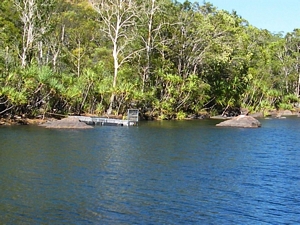
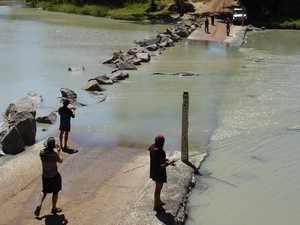
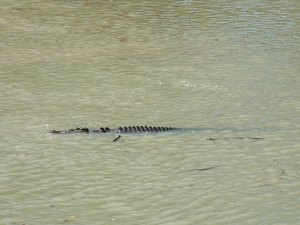
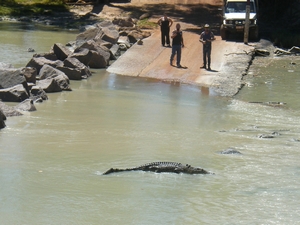
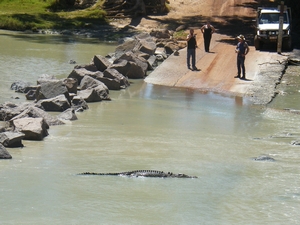
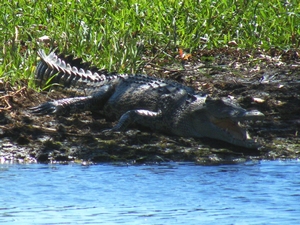
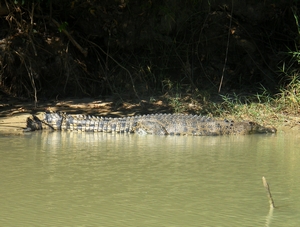
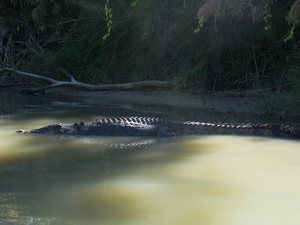
An ideal place to see many large crocodiles is from the viewing platform overlooking Cahills Crossing near Ubirr. As the tide rises, crocodiles line up to catch fish following the tidal surge. Park Rangers estimate that 100 -120 crocodiles can be seen within two kilometres of Cahills Crossing, and nowhere else is there such interaction between people and large numbers of crocodiles.
Despite signage as seen here at the boat ramp, people were fishing from Cahills Crossing. A man was taken from the crossing in 1987; Jabiru storeman Kerry McLoughlin was knocked into the river by the incoming tide and killed by a huge crocodile as he fished at Cahills Crossing. Another man was taken in 2017 while walking across the causeway.
The picture below was taken
in 2004 with water levels well and truly covering Cahills Crossing. Thanks to the traveller who has contributed and shared
this photo. There are children present in the water as well. All other photos were taken in 2009 (see more here).
Considering that over 100 crocodiles, some very large, feed in the area, standing in the turbid water is foolishness to the utmost.
A crocodile just below the surface cannot be seen. In the subsequent photos, crocodiles can be seen crossing the causeway at
much lower water levels.
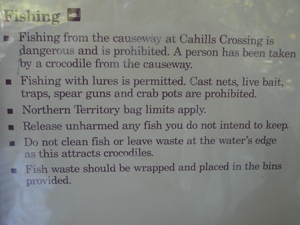
In addition to the Salt Water crocodile,
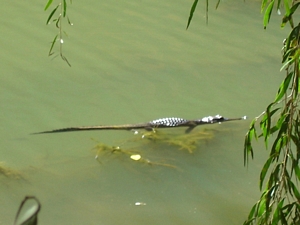

Crocodile attacks are a very real threat. On average two people lose their life to crocodiles annually in
Read about recorded crocodile attacks in Australia. 2014 was the worst on record for crocodile fatalities in the Northern Territory.
Another person well may have fallen victim to crocodile attack early in 2012, with no news in weeks
following the disappearance of a woman near the South Alligator River
Crocodile Safety: Obey signs – they are there for a very valid reason. In more remote areas, lack of
signage does not mean it is safe – just that it has not been signed and/or monitored. At many popular tourist attractions such
as Katherine Gorge and the plunge pools in Kakadu and
Do not camp
near the water in crocodile risk areas and do not leave scraps or fish offal anywhere near your camp.
When boating, ensure your craft is large and stable, and meets the requirements of the area (eg power boat only). Never dangle arms or legs over the edge of the boat. When fishing, be vigilant at all times.
What are the odds? See statistics on crocodile attacks
Read more on Crocodile Safety and how to be Crocodile Wise
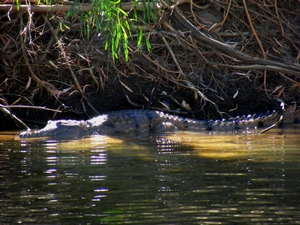
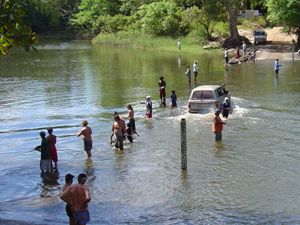
Use your browser back button to return to the page you were reading